
The Friends of 261, in conjunction with Canadian Pacific Railway, offered several excursions over the course of four weekends in August and September. I had ridden to Glenwood and Dresser the previous weekend and now, on September 15th, would be a double-headed excursion from Minneapolis, Minnesota to La Crosse, Wisconsin, where I would be joined by Chris Parker and Anton Lazzaro. That would be followed by a solo two-day trip to Winnipeg, Manitoba.
I worked five of the seven periods at McFadden Intermediate School before going home to grab my luggage and drove to the Santa Ana station this time to take Pacific Surfliner 775 to LAUPT and the Flyaway Bus to LAX. My wait was short as the train was on time.

Pacific Surfliner 775 arrived, the first picture I took with my new Canon EOS 35 mm camera. The consist was Pacific Surfliner cab bar 6905, Superliner baggage-coach 31018, coaches 6410, 6413 and 6451, coach/café 6351, Pacific Business Class 6803 with F59PHI 451. I boarded Business Class and the train made the stops at Anaheim and Fullerton before the final sprint to LAUPT, where we arrived on time. I walked to the Flyaway kiosk where I bought my round-trip ticket to LAX for eight dollars.
We departed late at 3:04 PM and avoided the bumper-to-bumper traffic on US 101 by taking surface streets. Once on California Highway 110, there was more bumper-to bumper traffic until we reached the car pool lane, which then allowed a smooth ride to LAX. I was dropped off at Terminal 2 and joined the Security line. I then heard "Northwest Airlines Flight 310 for Minneapolis" and a TSA agent walked me to a very short security line. I checked Gate 24A for Anton Lazzaro then went to the LA Roundhouse 66 Diner for some crispy chicken wings and some Coca-Cola then relaxed at the gate until my boarding time.
Northwest Airlines Flight 310 9/14/2007I was on board at 5:00 PM and chose Seat 14F on this A319 Aircraft. Anton made this flight just before the door closed. We took off at 5:32 PM PDT and I had two young women next to me who talked continuously for the whole flight. I did Sudoku puzzles and read my Canadian Trackside Guide. We landed at Minneapolis-St. Paul at 10:21 PM CDT then retrieved Anton's bag and learned Chris Parker's plane was due in at 12:10 AM. I took Anton on the Hiawatha Light Rail line from Lindbergh Terminal to Humphrey Terminal and back and both enjoyed the blast of cold thirty degree air as that stop was outside. We returned on the next train and waited for Chris Parker to arrive, which he did at 12:30 AM. He picked up the Alamo rental car and soon we were on Interstate 484 to Plymouth, where we checked into the Best Western Kelly Inn for our two-night stay. It took a while for me to fall asleep, but I got a solid five-and-a-half hours.
9/15/2007 We arose at 6:30 AM and met Anton at 6:50 AM before going McDonald's for breakfast then driving to Minneapolis Junction to board the doubleheader steam excursion.
Steam Doubleheader Trip with 261 and 2816 9/15/2007Built by the Montreal Locomotive Works in December 1930, it is the only non-streamlined Hudson to be preserved. The locomotive was primarily used in pulling passenger trains in revenue service for thirty years before it was retired in May 1960. In 1963, it was sold to F. Nelson Blount, who added it to his Steamtown, U.S.A. collection in Bellows Falls, Vermont. After becoming surplus in the collection by the National Park Service, 2816 was reacquired by the Canadian Pacific in 1998 and crews from BC Rail were hired to extensively restore it to operating condition.
Revenue serviceIt was first assigned to premier passenger service between Winnipeg and Fort William, Ontario. Following the introduction of semi-streamlined Royal Hudson locomotives in 1937, it was re-assigned to secondary passenger service between Windsor, Ontario and Quebec City and during the 1950's, it pulled commuter trains between Montreal and Rigaud, Quebec. In 1957, 2816 received a minor overhaul, with its tender being replaced with one from Royal Hudson 2822. The locomotive was retired from revenue service on May 26, 1960, after accumulating 2,046,000 miles and was subsequently used briefly as a stationary boiler at the St. Luc yards in Montreal.
Steamtown ownershipIn the early 1960's, F. Nelson Blount wanted to expand his Steamtown, U.S.A. collection and one of the locomotives he initially wanted to preserve was a 4-6-4 from the New York Central Railroad. Since all NYC 4-6-4s were scrapped by that time, Blount improvised by purchasing 2816 from the Canadian Pacific in December 1963. The locomotive was removed from the scrap lines of Angus, Ontario, and it was put on static display at Steamtown's first location in Bellows Falls, Vermont. During No. 2816's time on static display, the locomotive deteriorated from the outdoor elements and its condition worsened for several years. In the winter of 1983-1984, it was moved along with the rest of the collection to Scranton, Pennsylvania, where Steamtown was later reorganized as Steamtown National Historic Site under the ownership of the National Park Service. Following the reorganization, 2816 was deemed surplus in the collection and Steamtown wanted to dispose of it.
RestorationDuring the mid to late 1990's, the Canadian Pacific Railway's then-president and CEO, Robert Ritchie, reorganized the company and established the "Royal Canadian Pacific" excursion train to honour the railway's history and he sought for Canadian Pacific to operate their own steam excursion program. In 1998, the Canadian Pacific purchased 2816 from Steamtown and in exchange, the railway would move some equipment to Scranton. Canadian Pacific had heard of its availability via phone calls from BC Rail, who had been operating Canadian Pacific Royal Hudson 2860 as part of their own excursion program; the 2860 crews had been looking for replacement parts for the Royal Hudson and were offered to buy the entire locomotive by Steamtown.
A team of inspectors performed a preliminary inspection on 2816, and they pronounced that it was in good condition. In September 1998, the locomotive was coupled in a special consist led by Canadian Pacific GP38-2 3069, FP7 1400 and St. Lawrence and Hudson GP9u 8216, and it was ferried from Scranton to Montreal via Binghamton and Albany, New York, before travelling cross-country to the BC Rail steam workshop in North Vancouver, British Columbia. Canadian Pacific contracted the BC Rail steam shop crew, led by Al Broadfoot, to disassemble the steam engine and evaluate its condition; if it were salvageable, then they would restore it to operating condition, but if it were deteriorated beyond salvaging, then they would give it a cosmetic restoration for static display purposes.
When 2816 was disassembled, it was revealed that it was mechanically worn out, despite the preliminary inspectors having stated otherwise, but Rob Ritchie decided to approve a complete rebuild of the locomotive, regardless. Broadfoot and his team were able to obtain multiple plans and vital information about Canadian Pacific H1b class locomotives, including a collection of over 800 technical drawings provided by the Canada Science and Technology Museum and they used them as references for the project. Hundreds of replacement parts had to be fabricated by contractors in Vancouver, such as the cab, the running boards, the rod brasses, the superheater manifold, among others.
Contractors in the United States were hired to overhaul other major parts of 2816; the driving wheels were shipped to the Tennessee Valley Railroad Museum in Chattanooga, Tennessee and the boiler was shipped to Doyle McCormack and his crews in Portland, Oregon. 2816's firebox was converted from coal to oil firing and the tender received dual water intakes with Canadian and American threads. Canadian Pacific gained so much faith in the project that on April 19, 2000, the railway announced that it would be scheduled to return to service for their steam program by September of that year, but the deadline was pushed back, due to further challenges encountered in the restoration process. The project spanned more than two years and incurred costs between $3 million and $3.5 million.
Canadian Pacific excursion service and temporary hiatusOn August 15, 2001, 2816 passed its federal boiler inspection, and the following day, the locomotive was fired up for the first time in forty years, performing a series of test runs over three days on Canadian Pacific's Cascade Subdivision between Coquitlam and Mission. From September 19 to 23, with Al Broadfoot as the fireman and with Bill Stettler and Doyle McCormack taking turns as the engineer, 2816 pulled its first official inaugural excursion out of Port Moody, toured some of the Canadian Pacific mainlines for 672 miles over five days and then it stopped at Canadian Pacific's headquarters in Calgary, Alberta. The locomotive began pulling additional public relations excursions for the Canadian Pacific Railway, and it quickly received the name "The Empress".
On May 16, 2002, the locomotive pulled two excursions for the West Coast Express. Between May 24 and July 8, 2003, 2816 toured the Canadian Pacific between Alberta and Ontario, and the purpose of the tour was to spread further public awareness of Canadian Pacific and to raise money for the children's "Breakfast for Learning" program. On September 27, 2816 visited the Kamloops Heritage Railway and took part in a doubleheader excursion with Canadian National 2-8-0 2141. In May 2004, 2816 pulled the Royal Canadian Pacific consist while performing a 3,000-mile tour across the Canadian Pacific between Vancouver and Montreal, and it marked the first time in fifty years that a single steam locomotive pulled a cross-country passenger train in Canada, but it was assisted by three Canadian Pacific heritage diesels.
In early June 2004, the Empress was ferried behind a Soo Line SD60 over the CSX mainline between Buffalo, New York and Chicago, Illinois, hen it travelled to the Twin Cities area in Minnesota to participate in the Grand Excursion 2004 event, which celebrated the 150th anniversary of the Chicago and Rock Island Railroad's celebration train of 1854. 2816 pulled multiple public excursions for the event between the Twin Cities and the Quad Cities area in Iowa, using passenger coaches owned by Friends of the 261 and the last train took place on July 3; a doubleheader with Milwaukee Road 261 from St. Paul to La Crescent and return. 2816 returned from Minnesota to Calgary with a charity train later that same month.
Built by the American Locomotive Company in July 1944, 261 was originally operated by the Chicago, Milwaukee, St. Paul & Pacific Railroad, which was also known as the Milwaukee Road. The locomotive, weighing 460,000 pounds, is rated at a maximum of 4,500 hp and maximum speed of 100 mph is coal fueled. It had a 3 chime whistle and airhorn mounted on it. It operated with the railroad until retiring in 1954, and eventually donated to the National Railroad Museum in Green Bay, Wisconsin. As the new museum's first acquisition, 261 was moved to the museum site in 1958.
In 1991, the newly formed "North Star Rail" selected 261 for restoration for mainline excursions for a variety of reasons. The engine was large enough to handle the expected trains at track speed, it featured several modern features for a steam locomotive, including easier to maintain roller bearings, and it also already had its asbestos lagging removed, which is very expensive to remove for environmental and safety reasons. Finally, 261's relatively short 10-year service life meant that the engine's boiler is more pristine, meaning it would take less work to rebuild the engine.
North Star Rail and the National Railroad Museum came to an agreement in November 1991 for a ten-year lease (which was later renewed ten years later). 261 was moved from Green Bay to Minneapolis to the GE shops at Humboldt Yard in September 1992. There, a full-time staff rebuilt the engine. Work progressed quickly, allowing for a hydrostatic test in June 1993, a test fireup in July, and the eventual restoration completion in September. After passing the FRA inspection on September 14, the engine deadheaded over Wisconsin Central in time for its first public excursions on September 18-19, 1993. The engine later returned to its new home at the leased Burlington Northern Minneapolis Junction.
The following year, 261 had an extensive season including excursions on the Wisconsin Central Railroad and the Twin Cities and Western Railroad. Notable events included "Chocolate City Days" excusions, campaign trains, a movie shoot painted as "Lackawanna 1661", running over CSX tracks for the famed "New River Train", and a wrap up celebrating the engine's 50th birthday.
The engine participated in the Steamtown National Historic Site's grand opening in July 1995. Over five days, 261 deadheaded from Minneapolis to Scranton, Pennsylvania. The locomotive stayed in Scranton for the next year pulling numerous excursions, including rare mileage trips, a rare snow plow run, and the engine's first steam doubleheader with Susquehanna 142. A Hancock 3 chime whistle was temporarily added to the locomotive and then replaced with an AT&SF 6 chime whistle, which it remains with today, but still also keeping its original non-Hancock 3 chime whistle and airhorn. 261 returned to the Midwest after almost a year at Steamtown. On its way home, the engine made its first runs over the newly formed Burlington Northern Santa Fe Railway. It pulled a few sets of excursions in 1997 and 1998 over BNSF and TC&W trackage.
The year of 1998 presented 261 on its biggest assignment yet as it was the first steam engine to pull BNSF's Employee Appreciation Special. The engine led a BNSF locomotive and a dozen of BNSF's business fleet around the upper Midwest portion of the BNSF's route. This brought the engine back to Chicago before heading north to North Dakota and Montana, then through Minneapolis into Iowa before the EAS concluded at Topeka Railroad Days. 261 ended the 1998 operating season after a few more days on BNSF tracks going from North Kansas City to Lincoln to Sioux Falls back to the Twin Cities on a Camerail Club Excursion.
The 1999 season was short with a weekend excursion in May from Minneapolis to Duluth along with runs on the Lake Superior Railroad Museum's tracks, along with another excursion in September. The year 2000 saw 261 leading excursions out of places like Chicago, Omaha and Kansas City. The engine also led an AAPRCO special on August 29 to Duluth. The engine then led a long circle trip over the Duluth, Missabe and Iron Range Railroad as well as the North Shore Railroad System before heading back home. The 2001 season had excursions out of Minneapolis and Montevideo over BNSF and TC&W tracks during June and July, in a complete match of Hiawatha passenger cars. The next year, 261 pulled an almost matching consist between Minneapolis and Chicago. At this point, insurance rates were skyrocketing due to outside events as well as new FRA guidelines. The Friends of the 261 had an insurance policy to run through 2002, making these trips among the last time that the group could afford to have 261 run solo.
In the following months, some major changes were made to the Friends of the 261's operations. With insurance being too high to charge reasonable ticket prices, the group decided to team up with Amtrak. Amtrak is self-insured, so the added cost of excursion insurance was much less. However, Amtrak requires that all equipment meet Amtrak certification. The engine became the second steam engine to become Amtrak certified, and the Friends of the 261 began to buy or rebuild coaches that would meet Amtrak specifications. The first team up with Amtrak occurred in October 2003 with the engine's return to old Milwaukee Road tracks between Minneapolis to Winona, Minnesota. These trips have been repeated each year since.
In June 2004, the engine made its first return visit to Milwaukee since being restored, overnighting on its way to Chicago to participate in the Grand Excursion, an approximate reenactment of the original Grand Excursion of 1854. It departed from Chicago, arriving in Rock Island, Illinois to celebrate the 150th anniversary of the first railroad to reach the Mississippi River. During the Grand Excursion, 261 made day trips to Savanna, Illinois over the Iowa, Chicago and Eastern Railroad, and to Bureau Junction, Illinois on Iowa Interstate Railroad, current owner/operator of the first railroad line to the Mississippi. The train then traveled north along IC&E rails near the Mississippi River, making overnight stops at Dubuque, Iowa and La Crosse, Wisconsin. The final leg up to the Twin Cities operated in Wisconsin on BNSF trackage.
261 ran an excursion from Minneapolis to Duluth via BNSF trackage in both 2005 and 2007. Three June 2006 excursions were launched from Milwaukee: a dinner train in Friday 23 to Sturtevant, Wisconsin, and Saturday & Sunday excursions (24th & 25th) to Wisconsin Dells, Wisconsin. For these runs, the train was turned at New Lisbon.
In September 2006, 261 and its train visited Rock Island, Illinois as part of RiverWay 2006, a Quad Cities celebration of the 150th anniversary of the first railroad bridge across the Mississippi River in 1856. As part of the festivities, 261's train was coupled to a pair of Chinese-built QJ 2-10-2 steam locomotives for a trip to Homestead, Iowa, on September 15, 2006. The next day, 261 was added to run a "triple-header" from Rock Island to Bureau Junction, Illinois; then, on the following day, the QJs pulled the train, without 261, to Muscatine, Iowa, and back. Diesels were not used on any of these excursions.

Canadian Pacific Railway crew polishing their steam engine with Milwaukee Road 261 behind.

"Cedar Rapids" at the rear of our train, which had a consist of Canadian Pacific 4-6-4 2816, Milwaukee Road 4-8-4 261, Canadian Pacific tool car 29114, Canadian Pacific generator car 96, Canadian Pacific sleeper 110 "H.R. Bowen" PPCX 5534, coaches Canadian Pacific 101 "Dominion", Canadian Pacific 102 "Ernest "Smoky" Smith, VC, NSR baggage 9107 (in Canadian Pacific colors), RPCX 5534, PPCX 800798 "St. Paul Pass" 800798, NSR 203 "Nokomis", NSR "Wenonah", NSR baggage car X2450, NSR 31 "Minnesota River", NSR 3103 "Wisconsin Valley" PPCX 800757, PPCX 800862 "Super Dome" and Skytop observation car "Cedar Rapids" PPCX 800040.
Anton and I then found our seats in the "Nokomis" and then I went to find Chris to tell him where we were sitting.

I found Chris at the front end of the train still taking pictures. I reboarded then walked to the concession car and ran into Cary and Michelle from Alabama, who had driven here for this trip. It is always a fantastic thing to meet friends from over the years of riding excursions such as these. We departed at 8:30 AM and I found Chris Parker and Bob Riskie in the open door baggage concession car. We made our way towards St. Paul and just before we reached Westminster Hill, we went through the tunnel at the top of the hill, giving me a new route into town, then went down the hill, where at the bottom, we started paralleling the Mississippi River.
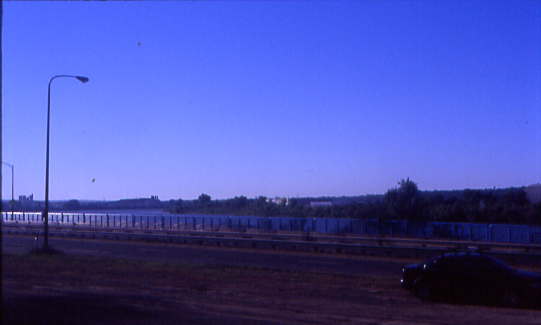
The Mississippi River.

A look back at the St. Paul skyline. The train made its way past Canadian Pacific's St. Paul Yard and BNSF's Dayton's Bluff Yard then steamed through Newport before we continuing to St. Croix, where I saw Lock and Dam 1 where I had photographed this same double-header in 2004, before turning southeast.


Crossed the Mississippi River Bridge at Hastings, Milepost 391.1, on a 320 foot lift bridge. We rolled through Hastings then by Vermillion and Blackbird.
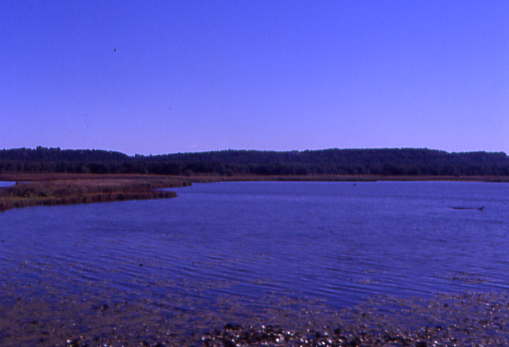
Travelling along the Mississippi River. We ran through Duke before arriving at Red Wing and a servicing stop for our pair of steam engines, where we stayed for about thirty minutes.

Passing under the highway bridge as we departed Red Wing and the line now left the river to make its way towards Lake City.

Interesting rocks near the top of this bluff.
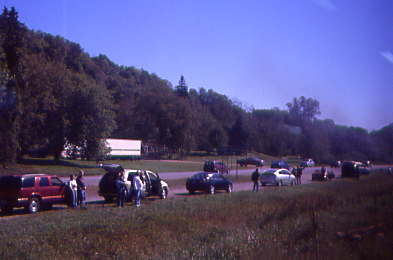
The chasers were getting ready to continue their mad dash for another picture.

Later, we started our trek along Lake Pepin.


Down by the water side.

The very wide Mississippi River at Lake Pepin.
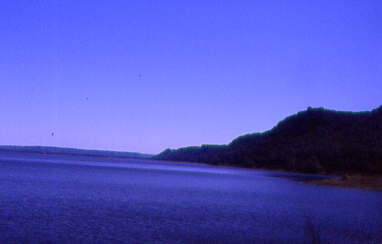
We ran below the palisades along the Minnesota side of the Mississippi River.

I am sure we surprised a few fisherman as our double-headed steam train blasted by their fishing locations.

Some sand bars built up in the river forming islands.

Another fishing boat as we rolled by.

Lily pads add to this beautiful scene.
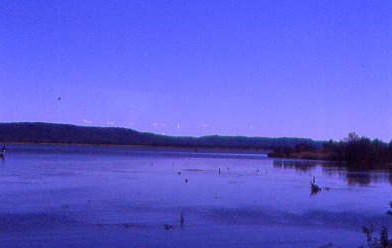
Great views abound along this most scenic route.

We paralleled the wide and deep Mississippi River.

The beauty continued.

The Milwaukee Road station in Winona, built in 1888 and a stop on Amtrak's Empire Builder, was passed.

A look down the river.


Interesting hills across the river in Wisconsin.

Rock formations.

We passed Lock and Dam 7 as we neared La Crescent, where we would turn east to cross the Mississippi River to reach La Crosse, Wisconsin, our destination.

The train made its way out onto the drawbridge across the Mississippi River.

Coming off the Mississippi River bridge, we entered Wisconsin.


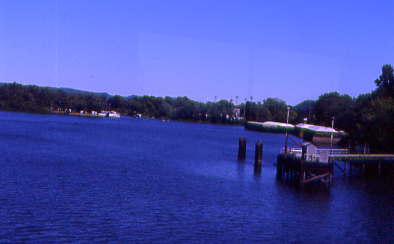
Crossing the Black River and soon after, we arrived at the La Crosse station where I detrained and joined the queue to pick up my lunch which I paid for on the train. It was announced that a photo runby would occur after Canadian Pacific 2816 was watered so I decided to find the best location that I could.
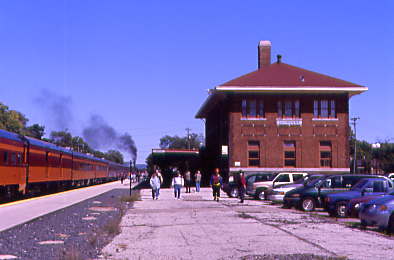
The Milwaukee Road La Crosse station built in 1927 which replaced an older station that burned in 1916. The station was listed on the National Register of Historic Places as the Chicago, Milwaukee and St. Paul Railway Depot and was renovated in 2001.

The "Cedar Rapids" looking beautiful in this bright late summer afternoon.

The rear of our train.

Up on the first bridge near the station provided this view which would be limited for the runby as this side only had the sidewalk. I decided to try the other bridge further west and once I arrived, we waited and soon heard a horn of a Canadian Pacific Railway freight train.


Canadian Pacific 8756 West passed through La Crosse and by the "Cedar Rapids". I saw paramedics down by the engines and soon it was announced that our photo runby was cancelled because a gentleman had tripped over the water hose and injured his head. I returned to the train to wait for the start of our trip back to the Twin Cities.